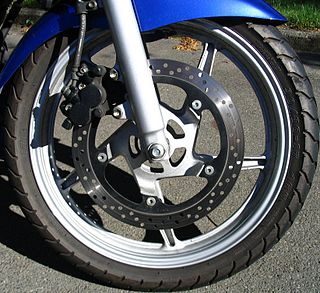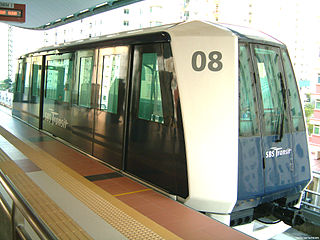
A pulley is a wheel on an axle or shaft that is designed to support movement and change of direction of a taut cable or belt, or transfer of power between the shaft and cable or belt. In the case of a pulley supported by a frame or shell that does not transfer power to a shaft, but is used to guide the cable or exert a force, the supporting shell is called a block, and the pulley may be called a sheave.

A brake is a mechanical device that inhibits motion by absorbing energy from a moving system. It is used for slowing or stopping a moving vehicle, wheel, axle, or to prevent its motion, most often accomplished by means of friction.

Suspension is the system of tires, tire air, springs, shock absorbers and linkages that connects a vehicle to its wheels and allows relative motion between the two. Suspension systems must support both road holding/handling and ride quality, which are at odds with each other. The tuning of suspensions involves finding the right compromise. It is important for the suspension to keep the road wheel in contact with the road surface as much as possible, because all the road or ground forces acting on the vehicle do so through the contact patches of the tires. The suspension also protects the vehicle itself and any cargo or luggage from damage and wear. The design of front and rear suspension of a car may be different.

Dynamic braking is the use of an electric traction motor as a generator when slowing a vehicle such as an electric or diesel-electric locomotive. It is termed "rheostatic" if the generated electrical power is dissipated as heat in brake grid resistors, and "regenerative" if the power is returned to the supply line. Dynamic braking reduces wear on friction-based braking components, and regeneration lowers net energy consumption. Dynamic braking may also be used on railcars with multiple units, light rail vehicles, electric trams, trolleybuses and electric and hybrid electric automobiles.

A turnbuckle, stretching screw or bottlescrew is a device for adjusting the tension or length of ropes, cables, tie rods, and other tensioning systems. It normally consists of two threaded eye bolts, one screwed into each end of a small metal frame, one with a left-hand thread and the other with a right-hand thread. The tension can be adjusted by rotating the frame, which causes both eye bolts to be screwed in or out simultaneously, without twisting the eye bolts or attached cables.

A conventional fixed-wing aircraft flight control system consists of flight control surfaces, the respective cockpit controls, connecting linkages, and the necessary operating mechanisms to control an aircraft's direction in flight. Aircraft engine controls are also considered as flight controls as they change speed.
Drive by wire, DbW, by-wire, Steer-by-wire, Fly-by-wire or x-by-wire technology in the automotive industry is the use of electrical or electro-mechanical systems for performing vehicle functions traditionally achieved by mechanical linkages. This technology replaces the traditional mechanical control systems with electronic control systems using electromechanical actuators and human-machine interfaces such as pedal and steering feel emulators. Components such as the steering column, intermediate shafts, pumps, hoses, belts, coolers and vacuum servos and master cylinders are eliminated from the vehicle. This is similar to the fly-by-wire systems used widely in the aviation industry.

The Crystal Mover is an automated people mover (APM) system for airport and light rail applications manufactured by Mitsubishi Heavy Industries in Mihara, Japan. The Crystal Mover is based on the Japanese APM standard, used in six Japanese automated guideway transit systems including the Yurikamome and the Rokko Island Line.

WAP 5 is the name of a class of "High Speed" electric locomotives produced and used by Indian Railways. The first 10 locomotives were imported from ABB in Switzerland in 1995. They are supposed to be a variant of the Swiss Lok 2000 and German DB Class 120.

In road vehicles, the parking brake, also called hand brake, emergency brake, or e-brake, is used to keep the vehicle stationary and in many cases also perform an emergency stop. Parking brakes on older vehicles often consist of a cable connected to two wheel brakes at one end and the other end to a pulling mechanism which is operated with the driver's hand or foot. The mechanism may be a hand-operated lever, at floor level beside the driver, or a straight pull handle located near the steering column, or a (foot-operated) pedal located beside the drivers leg. In most automobiles the parking brake operates only on the rear wheels, which have reduced traction while braking. Some automobiles have the parking brake operate on the front wheels, for example most Citroens manufactured since the end of World War II, and the early models of the Saab 900.

Track brakes are a form of brakes unique to railborne vehicles. The braking force derives from the friction resulting from the application of wood or metal braking shoes directly to the tracks. Early examples of track brakes used on the horse hauled mineral tramways that preceded the steam locomotive were described as sledge brakes, and are usually associated with lines that used gravity propulsion. In 1849 locomotive engineer Daniel Gooch fitted early examples of his Corsair Class tank engine with these devices; later these were replace with a conventional wheel brake.
Motorcycle components and systems for a motorcycle are engineered, manufactured, and assembled in order to produce motorcycle models with the desired performance, aesthetics, and cost. The key components of modern motorcycles are presented below.

The VL80 is a Soviet built electric AC mainline freight locomotive. The initials VL are those of Vladimir Lenin, after whom the class is named.

The Berkeley Hills Tunnel is a tunnel which carries Bay Area Rapid Transit's Antioch–SFO/Millbrae line through the Berkeley Hills between the Rockridge and Orinda stations.
Extended core stretch wrappers are rolls of stretch film which have their internal core extended beyond their film roll creating a handle by which film can be wrapped. Extended core wrapping is the lowest initial investment stretch wrapping system as no machinery is purchased. This system provides little control over stretch and is hard on workers' hands. Because of this, many stretch wrap users opt for low cost hand wrappers such as "hand savers" or mechanical brake systems.

Turntable stretch wrappers are a type of automatic and semi-automatic stretch wrapping system. A load is placed on a turntable, which rotates relative to the film roll, which is housed in a carriage attached to a vertical "mast" on which it may move up and down. In the simplest turntable systems, stretch is achieved by rotating the load at a speed in which the take-up demand on the load surface is faster than the rate at which the film is allowed to be fed, being limited by a brake system.

An Orbital stretch wrapper is a means of applying stretchable plastic film to a load, consisting of a roll of stretch wrap supported on a vertical rotating ring and a means of passing a load through the ring's eye horizontally. Several designs are available.

Toowoomba railway station is a heritage-listed railway station on the Western line at Russell Street, Toowoomba, Toowoomba Region, Queensland, Australia. It serves the city of Toowoomba, which is the junction for the Western, Main and Southern lines.The station has one platform with a passing loop, opening in 1867. It was designed by FDG Stanley and built in 1873 by R. Godsall. It was added to the Queensland Heritage Register on 21 October 1992.

















